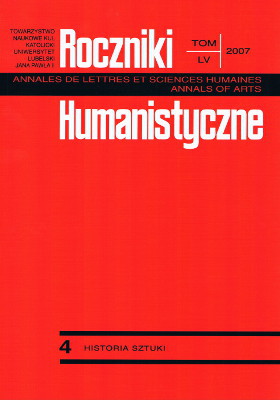Tadeusz Stryjeński i konkurs na projekt schroniska dla osieroconych i zaniedbanych chłopców z Fundacji im. ks. Aleksandra Lubomirskiego w Krakowie w 1887 roku. Przyczynek do działalności konkursowej architekta
Abstrakt
Tadeusz Stryjeński (1849-1943) was one of the most interesting and the most hard-working architects from Galicia. He was an active architect from 1878 until the 1930s. He was an author of over one hundred various objects (mainly public buildings and tenements) built in the territory of Kraków.
Architectonic contests were an important part in his professional activity. Tadeusz Stryjeński took part in twenty five contests and won in nine. For some reason independent of him he managed to implement only the plans from his first contest for the Contest for the design of a shelter for the neglected boys from the Prince Aleksander Lubomirski Foundation. The paper dwells on the history of the contest and traces the history of the building of the shelter according to the press of that time (one of the most interesting examples of neo-Renaissance in the monumental architecture of Kraków at the end of the nineteenth century).
The text is preceded by some considerations on the principles of organising contests and the role of the Circles of Polish Architects in Warszawa and in Lvov, the Technical Society in Kraków. These organisations played an important role in establishing (in December 1908) the Delegation of Polish Architects, an organisation designed mainly to defend architects in their jobs and solve the problems of their milieu, including the touchy question of the contests. In all these activities Tadeusz Stryjeński took an active part.
Bibliografia
Lameński Lechosław, Tadeusz Stryjeński (1849-1943) – architekt, konserwator i przemysłowiec krakowski. Biografia, „Towarzystwo Naukowe w Rzeszowie”. Prace Humanistyczne, Seria I, 1991, z. 30, s. 59-101, il.
Meus Rajmund, Schronisko dla chłopców fundacyi imienia ks. Lubomirskiego wKrakowie, „Czasopismo Techniczne” 1888, nr 24, s. 201.
I Zjazd delegatów kół architektonicznych polskich w Krakowie 1908, „Architekt” 1909, z. 1, s. 1-5.
Ponikło Stanisław, Das Fürstlich Lubomirski'sche Asyl für vernachlässigte Knaben in Krakau, Wien und Prag 1896, ss. 6, ilustr.
Ponikło Stanisław, Schronisko fundacji ks. Alexandra Lubomirskiego w Krakowie, „Tygodnik Ilustrowany” 1898, nr 13, s. 247, ilustr.
Poświęcenie i otwarcie schroniska dla osieroconych chłopców fundacyi ks. Aleksandra Lubomirskiego, „Czas” 1893, nr 253, s. 2.
Program do projektu konkursowego na budowę schroniska dla chłopców fundacyi imienia księcia Lubomirskiego w Krakowie, „Czasopismo Techniczne” 1887, nr8, s. 94-94.
Położenie kamienia węgielnego pod schronisko fundacji ks. Lubomirskiego, „Czas” 1891, nr 226, s. 1.
Protokół I Zjazdu delegatów kół architektonicznych polskich w Krakowie 1908, „Czasopismo Techniczne” 1909, nr 1, s. 5-7.
Rozmaitości, „Czasopismo Techniczne” 1887, nr 12, s. 151 (przedłużenie terminu konkursu); tamże, 1888, nr 2, s. 4 (wykaz nadesłanych projektów).
Schronisko dla chłopców fundacyi ks. Al. Lubomirskiego w Krakowie, „Czasopismo Towarzystwa Technicznego Krakowskiego” 1893, nr 22, s. 263-264.
Schronisko im. ks. Lubomirskiego, „Gazeta Narodowa” 1885, nr 239, s. 2.
Sprawy Towarzystwa. Zasady konkursów architektonicznych opracowane i przyjęte przez „Koło Architektów Polskich we Lwowie”, a zatwierdzone przez Towarzystwo Politechniczne, „Czasopismo Techniczne” 1909, nr 7, s. 82-84.
Warunki ogólne konkursów architektonicznych przyjęte przez Koło Architektów wWarszawie, „Przegląd Techniczny” 1912, nr 11, s. 140.
„Wiener Bauten-Album” (dodatek do „Wiener Bauindustrie-Zeitung”) 5(1888), Blatt 81-82, 83-84.
Z I-ego Zjazdu Delegatów Kół Architektonicznych Polskich w Krakowie (1908), „Przegląd Techniczny” 1908, nr 52, s. 635-636.
Zasady konkursów architektonicznych opracowane i przyjęte przez Koło Architektów Polskich we Lwowie, „Przegląd Techniczny” 1909, nr 18, s. 124; nr 20, s. 247-248.
Copyright (c) 2007 Roczniki Humanistyczne

Utwór dostępny jest na licencji Creative Commons Uznanie autorstwa – Użycie niekomercyjne – Bez utworów zależnych 4.0 Międzynarodowe.





